Saint Patrick’s Global Footprint: How the World Honours Ireland’s Patron Saint
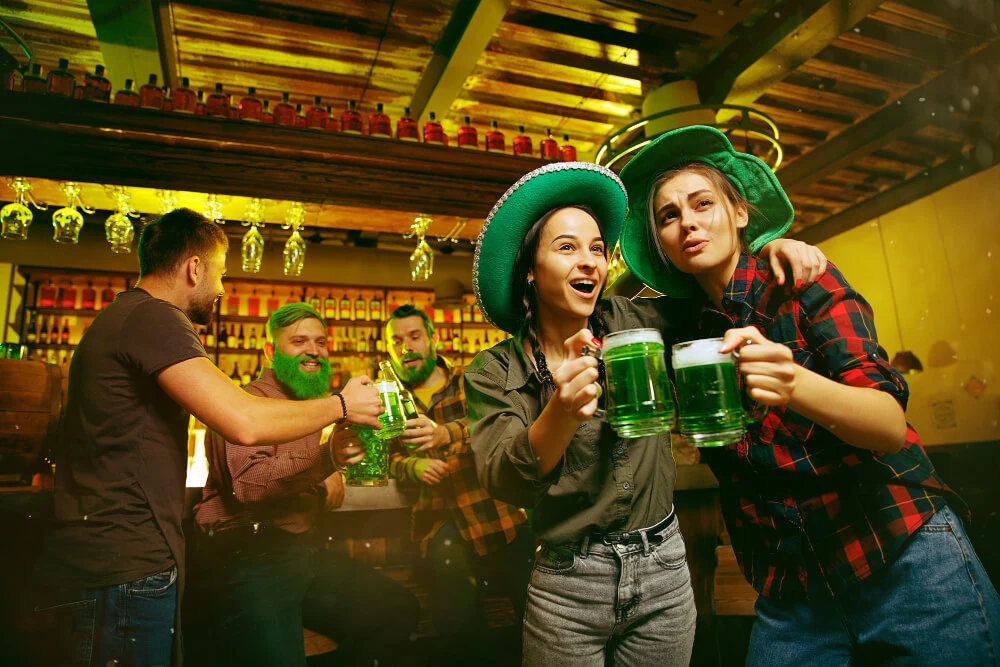
Updated On: April 22, 2024 by Yasmin Elwan
As the emerald isle celebrates its patron saint, Saint Patrick, we’re reminded of the remarkable global footprint left by this historic figure. Every year, on March 17th, people from all corners of the world come together to honour Saint Patrick, who is widely associated with bringing Christianity to Ireland. Though the traditions began on the island nation, St Patrick’s Day has transcended its origins, transforming from a religious observance into an international festival of Irish culture.
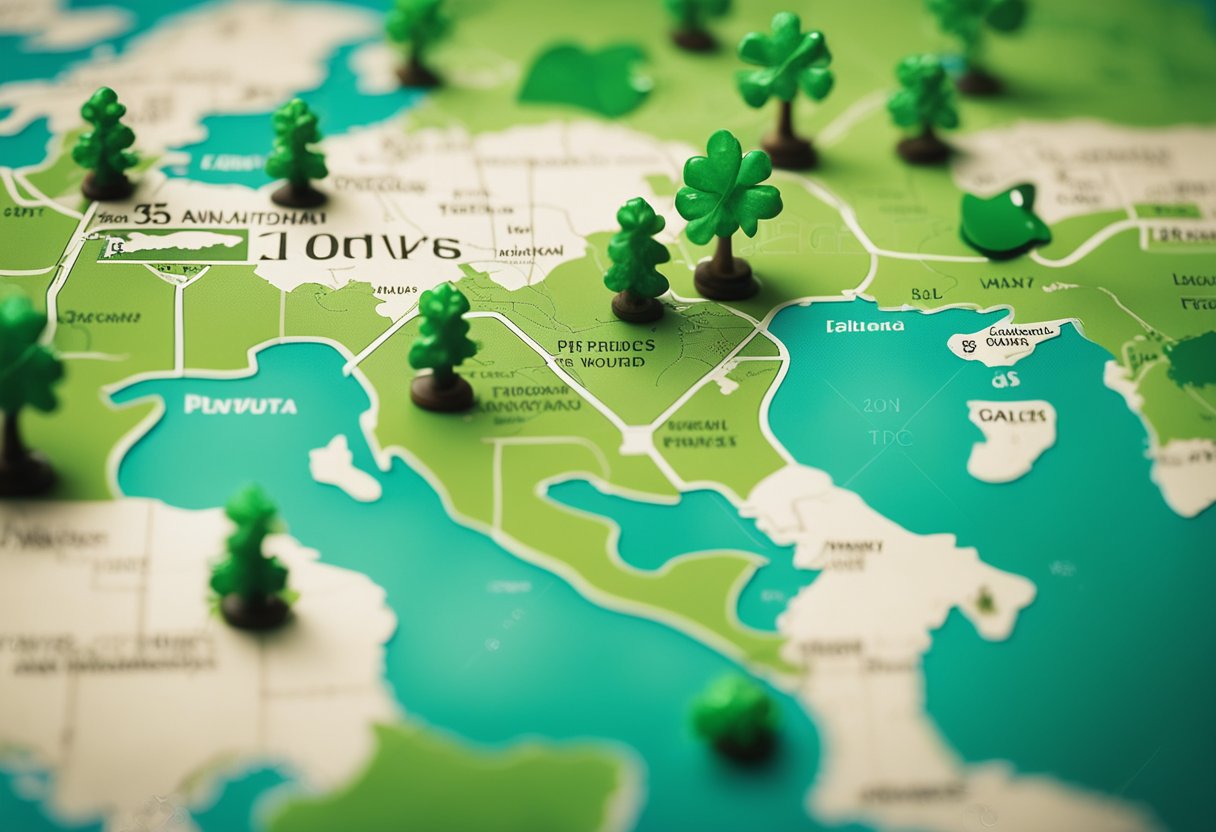
The global adoption of St Patrick’s Day reflects both the widespread diaspora of the Irish and the world’s affinity for Ireland’s heritage. From the lively parades in the United States to the iconic landmarks donning green lights in Australia, the day is marked with jubilation and cultural pride. Beyond the festivities, Saint Patrick’s contributions to Irish identity and the holiday’s ability to bridge cultural divides underscore the lasting legacy of Ireland’s patron saint.
The Life and Legacy of Saint Patrick
The patron saint of Ireland, Saint Patrick, stands as a towering figure in the history of Christianity. His life’s work and enduring legacy continue to influence and inspire people globally.
Early Life and Capture
Saint Patrick, born Maewyn Succat, was a nobleman in Roman Britain in the late 4th century. At the age of sixteen, he was captured by Irish raiders and sold into slavery in Ireland. This tumultuous period would be the catalyst for his spiritual awakening and eventual sainthood.
Spiritual Transformation and Mission
After six years of enslavement, Patrick escaped and returned to his family. He experienced a profound spiritual transformation, which led him to study for the priesthood and eventually return to Ireland as a missionary. His tireless efforts to establish monasteries, schools, and churches played a pivotal role in spreading Christianity across Ireland.
Saint Patrick and the Holy Trinity
One of the most iconic teachings of Saint Patrick involves the use of the shamrock, a three-leafed plant, to explain the concept of the Holy Trinity to the Irish people. Although he did not drive snakes out of Ireland, as myth suggests—since there were none—his symbolic victory over pagan practices deeply embedded him within the Irish consciousness as the national apostle.
St Patrick’s Day Origins and Global Adoption
St Patrick’s Day has transitioned from a humble religious observance to a vibrant global celebration. We shall explore its origins and how it has become adopted worldwide.
From Religious Observance to Public Holiday
St Patrick’s Day, observed on March 17, commemorates the patron saint of Ireland, St Patrick. Initially a religious holiday, it has a rich history dating back to the early 17th century when it was marked in the liturgical calendar. Within the Republic of Ireland and Northern Ireland, this day morphed from a strictly religious event into a national holiday characterised by public festivities. Dublin, the capital city, is particularly renowned for its magnificent St Patrick’s Day parade, reflecting the day’s significant transformation.
In the Irish diaspora, especially in territories where Irish immigrants settled, such as the United States and Canada, St Patrick’s Day has been zealously adopted. The earliest record of a parade dates back to 1601 in a Spanish colony, now part of St. Augustine, Florida, indicating the day’s longstanding international footprint.
Expansion of St Patrick’s Day Worldwide
The spread of St Patrick’s Day celebrations across the globe encapsulates the widespread influence of Irish culture. The international community, from the Americas to Australia, eagerly embraces the holiday with various celebrations — including parades, music, and the symbolic wearing of green. The expansion reflects not only the movement of the Irish diaspora but also the world’s fascination with Ireland’s rich cultural offerings.
As we witness today, major cities around the world, from New York to Sydney, host impressive festivities on March 17, uniting people of all backgrounds in the spirit of Irish heritage. These events propel the holiday beyond the confines of Ireland, illustrating its global reach and adoption.
Cultural Celebrations and Symbols
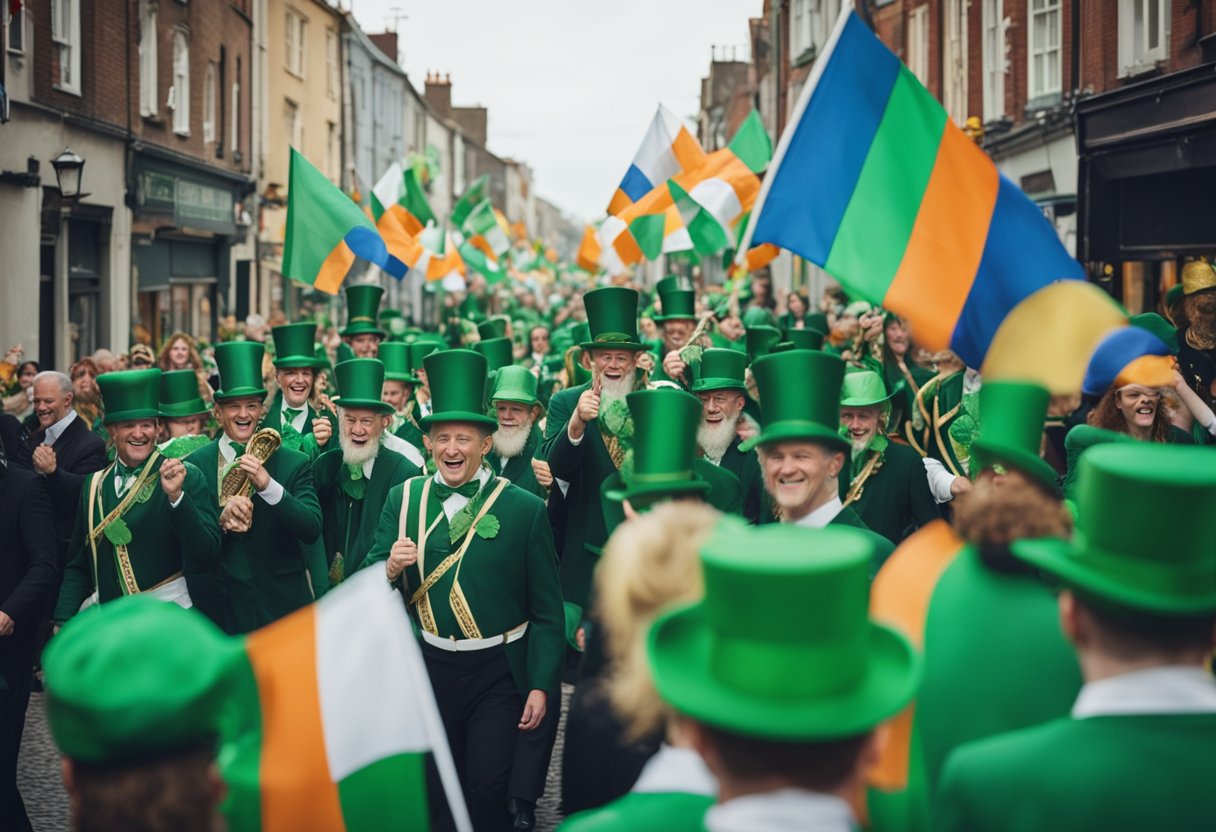
In the lively spread of St. Patrick’s Day festivities, parades and the shamrock symbol stand as proud emblems of the enduring spirit and cultural heritage of Ireland.
Parades and Festivities
Every March 17, major cities across the world stage grand parades and public gatherings imbued with a distinctly Irish flair. Streets are awash with green, as the colour symbolises not just the lush landscapes of Ireland but also the rebirth associated with spring and St. Patrick’s use of the shamrock. An array of special foods like corned beef and cabbage often feature in these celebrations, which offer a taste of Irish culture regardless of geographic location.
Symbols of St Patrick’s Day and The Shamrock
The shamrock, a sprig of clover, has been linked to St. Patrick’s teachings about the Christian Holy Trinity, and it bears significant religious and cultural weight. Meanwhile, cherubic leprechauns, part of Ireland’s fairy folklore, symbolise a quirky, magical aspect of Irish culture, often depicted with their pots of gold. Buildings around the world have been known to bask under green light as part of global celebrations, encapsulating the infectious Irish spirit that bridges countries and cultures.
St Patrick’s Day in the United Kingdom and Ireland
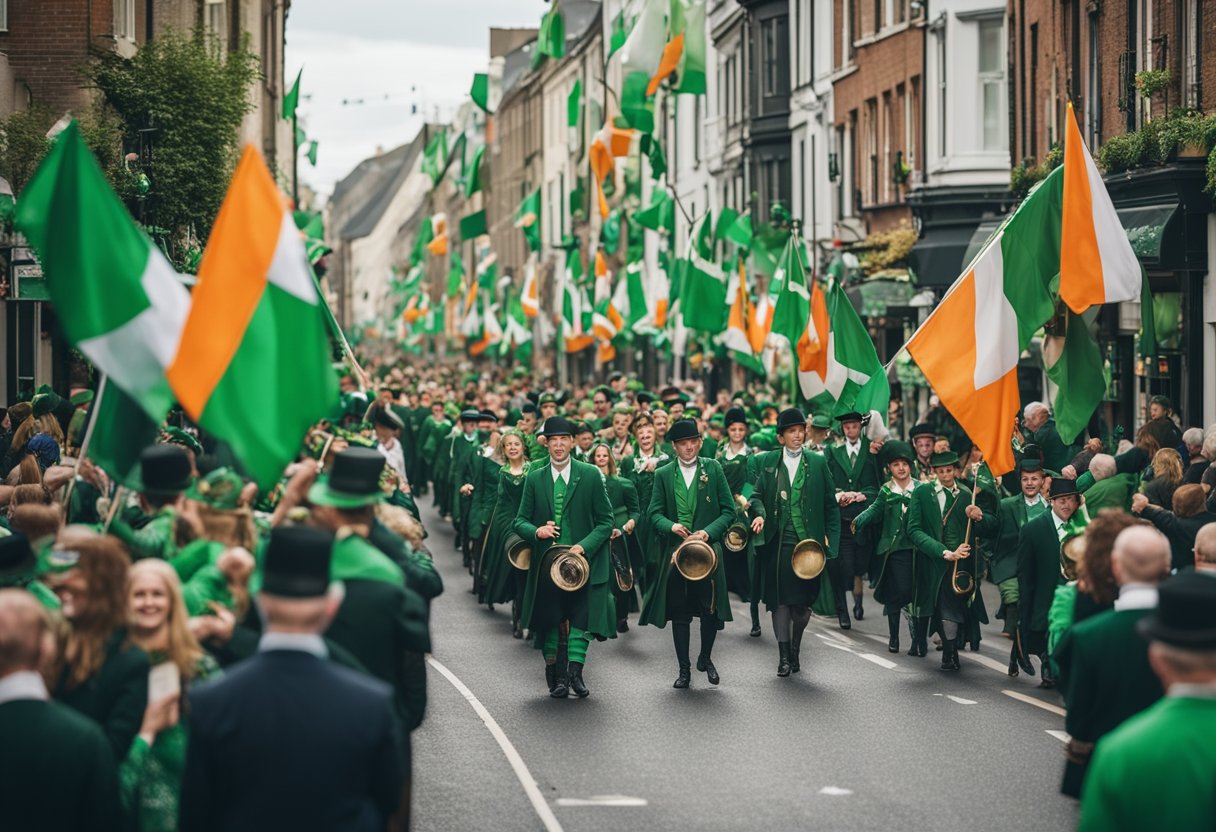
We observe St Patrick’s Day as a vibrant and cultural event, celebrating Ireland’s patron saint with festivities that echo through the United Kingdom and Ireland. Northern Ireland marks the day with bank holiday cheer, while the Republic of Ireland radiates with parades and festivities, particularly in Dublin.
Traditions in the Republic of Ireland
In the Republic of Ireland, St Patrick’s Day is a public holiday replete with parades, cultural events, and an upsurge in tourism. Dublin, as the heart of the nation’s celebrations, plays host to the largest parade, where streets come alive with a display of Irish heritage and a sea of green. Music, dancing, and street performers line the route, giving locals and visitors alike a sense of the rich culture.
St Patrick’s Celebrations in Northern Ireland
St Patrick’s Day in Northern Ireland is characterised by a distinct blend of cultural pride and historical reverence. Downpatrick, known as the burial place of St. Patrick, becomes a focal point for both religious and community-led events. The city, closely associated with the saint, sees Down Cathedral and the surrounding area bustling with tours and visitors keen to honour the patron saint’s legacy.
North American Festivities: Beyond the Irish Shores
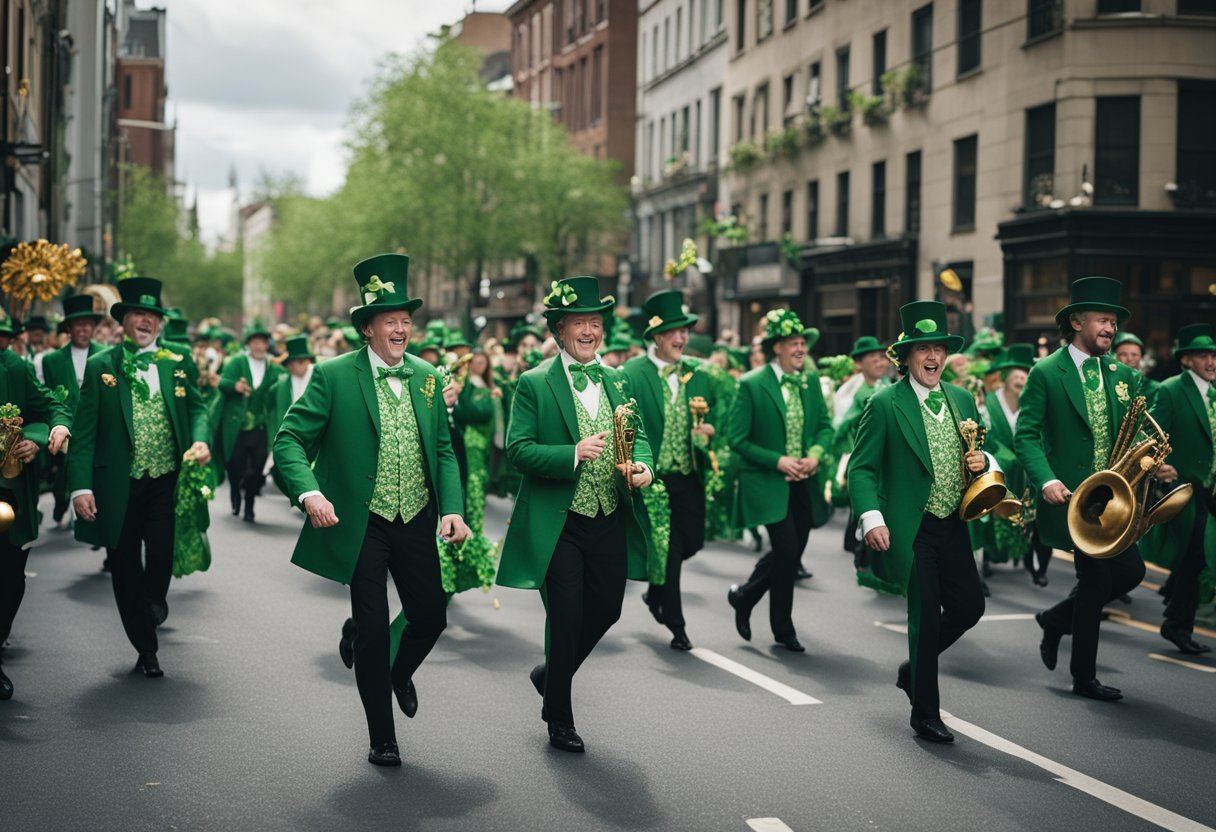
In North America, St. Patrick’s Day festivities are a vibrant testament to the enduring connection between the Irish diaspora and their cultural roots. Particularly in the United States and Canada, cities like Chicago and Boston proudly showcase Irish heritage through unique celebrations and public events.
The Iconic Chicago River Dyeing
Chicago, home to a significant Irish community, boasts one of the most visually striking St. Patrick’s Day traditions—the dyeing of the Chicago River. Every year, onlookers gather as the river transforms into an emerald waterway, a spectacle made possible by the safe, eco-friendly dye that has been used for over half a century. This vibrant annual event unites the city in a shared appreciation of Irish culture and revelry.
Boston’s Irish Heritage and Parades
Boston, with its deeply-rooted Irish heritage, hosts a range of festivities honouring Ireland’s patron saint. The city’s St. Patrick’s Day parade is a highlight, renowned for its lively floats, bands, and performers. At the heart of these celebrations are the contributions of Irish immigrants who have shaped the city’s character since their arrival. These parades are more than just a display of green; they’re a powerful display of Boston’s Irish identity and historical bonds with Ireland.
St Patrick’s Day in Australia and Oceania

As we observe St Patrick’s Day, Australia and Oceania’s celebrations reflect the enduring influence of Irish immigrants in this region. Cities across Australia illuminate landmarks in green, symbolising a connection to Irish culture that resonates with many citizens.
Sydney’s Celebrations and the Opera House
In Sydney, St Patrick’s Day is an event of grandeur, with the iconic Sydney Opera House often basked in a vibrant green light. This transformation not only honours St Patrick, the patron saint of Ireland, but also recognises the cultural contributions of the Irish immigrants who have become an integral part of Australia’s social fabric. The city hosts an array of events that draw in both locals and visitors, coming together to celebrate the holiday with parade floats, music, and dance. The day is a testament to a shared heritage that stretches across oceans, linking Ireland’s past to Australia’s diverse present.
Emerald Celebrations in Other Parts of the World
As Ireland’s patron saint, St. Patrick’s influence reaches far and wide, with celebrations of Irish culture and heritage taking place across the globe, presenting a blend of traditional Irish festivities with unique cultural twists.
St Patrick’s Day in Asia and Africa
In parts of Asia and Africa, St. Patrick’s Day brings a touch of the Emerald Isle to regions rich in their own customs. Nigeria often marks the day with festivities reflecting its own cultural practices, intertwining them with the recognition of St Patrick, who is also a patron saint of the country due to the bond created by Irish missionaries.
An extraordinary blend of Irish and Caribbean culture emerges on Montserrat, known as the ‘Emerald Isle of the Caribbean’. This island is one of the few places in the world that marks St. Patrick’s Day as a national holiday, commemorating both their Irish heritage and an uprising against colonialism with a week-long festival that includes a lively parade.
European Celebrations Outside of Ireland
Beyond the borders of Ireland, Europe embraces St Patrick with open arms, illustrating the saint’s global footprint. London hosts a grand parade showcasing the strong Irish influence within the city through floats, marching bands, and a festival in Trafalgar Square.
Meanwhile, in Glastonbury, England, revellers can enjoy a spiritual angle to the day, with events that highlight the alleged connection between St Patrick and the ancient town, drawing on mythology to provide a distinct celebration.
Our explorations offer a glimpse into the worldwide embrace of St. Patrick’s Day, showcasing the enduring legacy and cultural connectivity of Ireland’s patron saint. Irish festivities have indeed found international resonance, uniting people from different backgrounds in wearing green and honouring St Patrick’s heritage.
Modern Transformations and Challenges
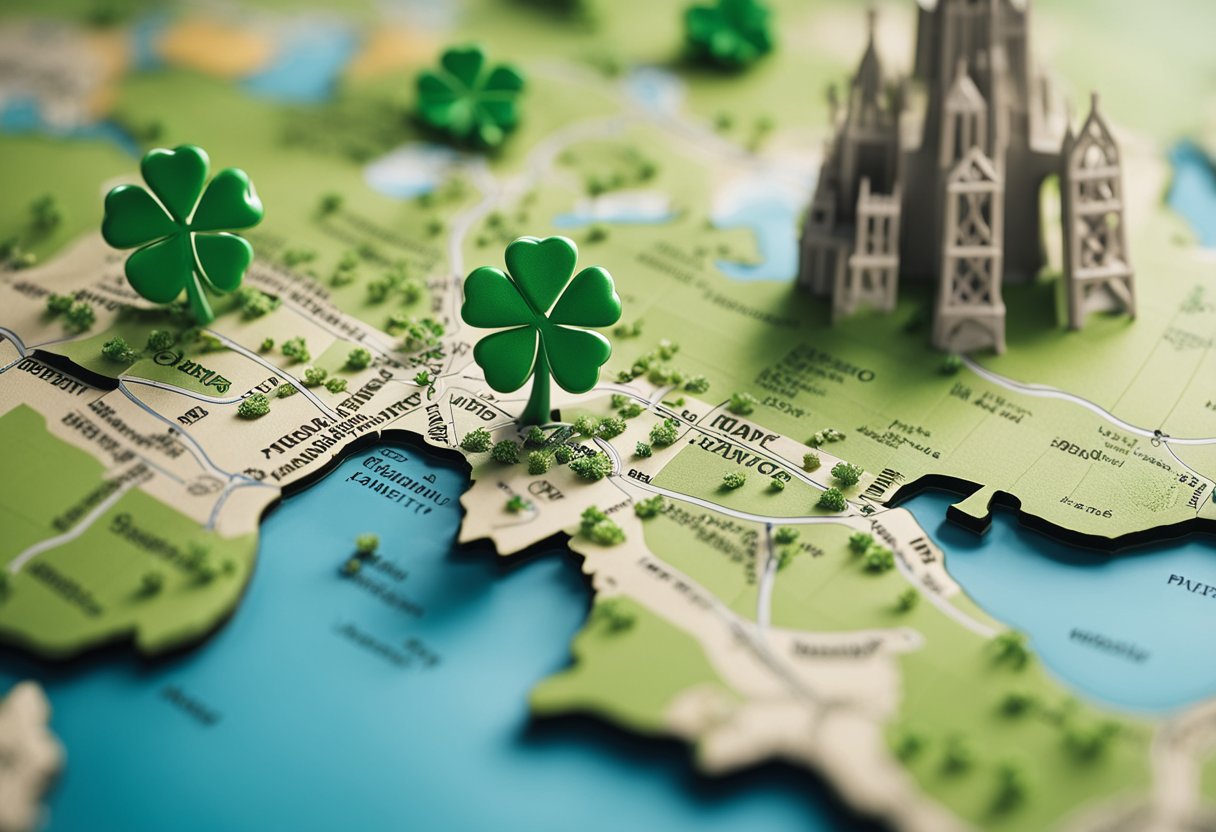
In recent years, the global celebration of St. Patrick’s Day has undergone significant changes, particularly in the face of challenges like the coronavirus pandemic. These transformations have seen both detriments and innovative responses to new-world problems.
Coronavirus Pandemic’s Impact on Celebrations
The coronavirus pandemic has necessitated drastic changes in how we commemorate St. Patrick’s Day. Large public gatherings, once a staple of the March 17th festivities, have been curtailed to prevent the spread of COVID-19. Many countries were compelled to cancel their traditional parades and events, shifting to virtual celebrations as a means of continuing the tradition safely.
These online events represent a modern reimagining of communal celebration, with live-streamed parades, concerts, and church services allowing us to maintain a sense of global connection despite physical distances. Our resilience and creativity are evident as communities worldwide find new ways to honour Ireland’s patron saint, ensuring that St. Patrick’s legacy continues to be celebrated across continents.
The Culinary Side of St Patrick’s Day
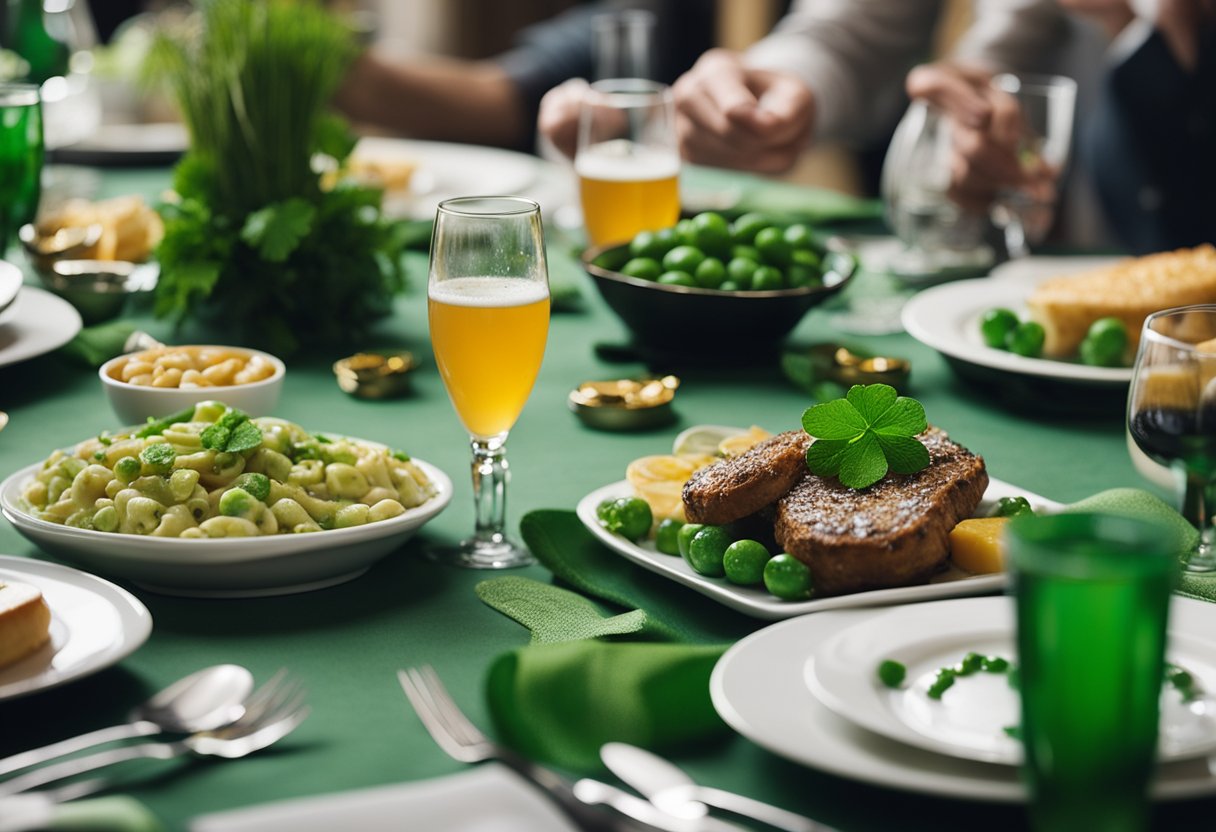
As we celebrate St Patrick’s Day across the globe, the spotlight often shines on the delectable Irish cuisine that accompanies the festivities. The traditional foods and libations play a pivotal role in the day’s observances, reflecting a rich cultural heritage that’s enjoyed by many, regardless of their lineage.
Traditional Irish Foods and Drinks
When it comes to St Patrick’s Day, certain dishes and beverages are synonymous with the occasion. Corned beef and cabbage is a classic dish that many associate with the holiday. Interestingly, this combination is more of an Irish-American tradition rather than a meal typically enjoyed in Ireland itself.
In Ireland, bacon and cabbage is more authentically the dish of choice, often accompanied by Irish soda bread. Across the world, menus at various pubs and restaurants feature this hearty meal, paying homage to Irish culture.
Guinness, the esteemed Irish stout, takes centre stage in many toasts on St Patrick’s Day. Its rich, creamy texture and deep, ebony hue are essential aspects of the celebration. Remarkably, it’s said that about 13 million pints of Guinness will be consumed worldwide on St Patrick’s Day.
When it comes to special foods, one cannot forget the Irish scones and soda bread. Scones, rich and buttery, sometimes with added ingredients for a twist, such as Jalapeño-Cheddar, are beloved treats on this day.
The Lenten season’s proximity to St Patrick’s Day does bring about certain religious observances, including Lenten prohibitions. However, it’s a tradition for those observing Lent to take a reprieve from their fast on St Patrick’s Day, allowing full participation in the culinary indulgences of the celebration.
Finally, the significance of Lent leading up to St Patrick’s Day cannot be understated. In Ireland, Lent was historically a time when prohibitions against the consumption of meat were lifted for the day, allowing for the special meal that has since evolved into the corned beef and cabbage many relish today.
Our collective enjoyment of these culinary traditions serves not just as a nod to the past but as a way to connect with each other worldwide through the shared experience of a meal.
St Patrick and the Influence on Irish Identity
Saint Patrick’s impact on Ireland reaches far beyond his historical and religious significance, touching and shaping the very essence of Irish identity.
Irish Diaspora and the Spreading of Traditions
We recognise the role of the Irish diaspora in proliferating the customs and practices associated with St Patrick, which have become hallmarks of Irish heritage worldwide. Throughout history, waves of emigration have dispersed the Irish people and their traditions across the globe, embedding tales of Ireland’s patron saint in numerous societies.
In particular places like St Augustine, Florida, the oldest Spanish colony in the United States, Irish immigrants played a pivotal role in the community, bringing with them the cultural celebrations of St Patrick that endure to this day. This migratory pattern has seen St Patrick’s Day transform from a predominantly Irish celebration into a global phenomenon, where the spirit of Ireland is vivaciously alive through parades, music, and dance.
Through these global celebrations, the legacy of Saint Patrick is preserved and shared, reinforcing a sense of belonging and cultural pride amongst Irish communities, no matter how far from their ancestral homeland.
Historical and Mythological Connections
As we examine the historical and mythological narratives surrounding Saint Patrick, it’s apparent that his impact on Irish culture and the spread of Christianity is interwoven with tales that resonate far beyond the shores of Ireland.
Saint Patrick’s Association with Snakes
One of the most enduring legends associated with Saint Patrick is the claim that he banished all snakes from Ireland. While this is a compelling story, it is generally considered a metaphor reflecting his efforts to eradicate pagan practices and establish Christianity. Considering Ireland’s post-glacial history, it is scientifically unlikely that snakes ever inhabited the island, thus hinting at the mythological nature of the tale within Irish culture.
The Historicity of St Patrick’s Narratives
Saint Patrick’s life is a complex tapestry of historical facts and hagiographic myths. Born in Roman Britain, he was captured and taken to Ireland as a slave. The historical Saint Patrick is credited with founding monasteries and spreading Christianity across Ireland. However, sorting the actual man from his mythologised persona presents challenges, as many of the miraculous feats attributed to him, such as using the shamrock to explain the Trinity, are difficult to verify historically. Nevertheless, these narratives have become deeply ingrained in Irish culture and mythology, highlighting the intertwining of history and legend in celebrating Saint Patrick’s legacy.
Frequently Asked Questions
As we explore the significance and global impact of St Patrick’s Day, let’s address some common queries people have about the celebration of Ireland’s patron saint.
What is the spiritual significance of St Patrick’s Day?
St Patrick’s Day honours the revered patron saint of Ireland, St Patrick, who is credited with bringing Christianity to Irish shores. His missionary work in the 5th century and the symbol of the shamrock, which he purportedly used to explain the Holy Trinity, hold deep spiritual significance for many.
In what ways is St Patrick’s Day celebrated internationally?
Internationally, St Patrick’s Day is marked by parades, the wearing of green, and public gatherings. Many landmarks participate in the Global Greening campaign, illuminating in green to show solidarity with Irish culture.
For what reasons do various countries observe St Patrick’s Day?
Countries observe St Patrick’s Day to honour Irish heritage and culture. From the presentation of shamrock to the US president to diverse communities celebrating the influence of the Irish diaspora, the day is a recognition of Ireland’s cultural contributions globally.
What is the historical background for celebrating St Patrick’s Day on the 17th of March?
St Patrick’s Day always falls on the 17th of March as it is believed to be the death anniversary of St Patrick. This day has been observed by the Irish as a religious feast day for over 1,000 years and has evolved into the current form of global celebration.
What does St Patrick represent for Ireland?
For Ireland, St Patrick is a symbolic figure representing the country’s rich history and religious tradition. He epitomises the resilience of Irish identity and its spread across the world, symbolising unity and the spirit of the Irish people.
Which location hosts the grandest St Patrick’s Day festivities?
While Dublin boasts a vibrant and grand celebration, cities such as New York and Boston also host large-scale parades and events attracting millions, reflecting their substantial Irish-American communities and their connection to Irish traditions and heritage.






